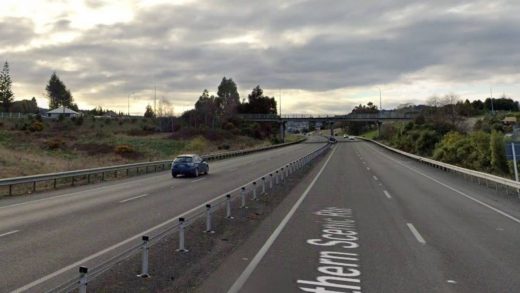
You can imagine that Elaine Sanderson chats to her plants when she’s gardening, just as she chats to guests – laughingly admonishing herself, musing out loud and occasionally cursing the natural elements she battles with at her coastal Taranaki property. The garden, with its winding paths, colour, strong foliage and features inspired by overseas travel, reflects her personality. She modestly refers to the garden as higgledy piggledy or just a hotchpotch but the exuberant character-filled property is certainly a delight. It’s a regular participant in the Taranaki Garden Festival and is featured on the New Zealand Gardens Trust circuit.
Jane Dove Juneau/NZ House & Garden
Elaine Sanderson, who gardens full-time with the help of family and her neighbour, ensures thereâs colour year round at her Taranaki property, either with flowers or foliage; this old wheelbarrow is full of purple and white flowering lobelia interspersed with pink geraniums.
Elaine and husband John moved onto their Ōtākeho farm, 30km along the coast from Hāwera, when they married. Eldest daughter Natalie was born in 1988 around the same time the garden started sprouting.
READ MORE:
* This magnificent Taumarunui garden is full of unexpected surprises
* There’s so much more to this Tauranga garden than structure and simplicity
* Creative thinking took this Auckland garden from damp to dreamy
“When you have kids you don’t want to be in the house with them… they love being outside.” So she gardened while the kids played. There are now three grown daughters and a son.
Like many rural gardeners, Elaine started with a ledger of positives and negatives. On one side of the ledger was flat land unfettered by fences. On the debit side was a lack of natural shelter and strong coastal wind. Salt spray was a particular irritation and it took years to get the shelter right, she says.
Jane Dove Juneau/NZ House & Garden
A Pyrus salicifolia pendula (weeping silver pear) tree surrounded by corokia and lavender grow where cows once grazed; in the foreground mounds of Buxus microphylla ‘Koreana’ and a climbing wisteria disguise an old farm gate.
“In the early 90s it was a cottage-style garden – as the style was at the time. Then I planted a whole lot of natives.” They got too big and many were removed, however, the plants that stayed combined with other established vegetation to provide structure.
“That’s when I really started to have fun. I had the overhead shelter by then and could create micro-environments underneath. I’d figured out what grew so well here… things were self-seeding so I could shift them around.”
Jane Dove Juneau/NZ House & Garden
A potted heuchera picks up the colours of the bright orange and brown cushions; the garden furniture was made from railway sleepers on-site by a builder.
Nowadays Elaine is a full-time gardener. “She used to do about 1200 hours a year. Now it’s about 2000 hours a year,” says John, grinning when asked if he keeps a timesheet. Elaine agrees: “I don’t go to town very often. Online shopping suits me just fine.”
Her mother was a keen floral artist and her granddad grew roses, however it was good friend Jenny Oakley who inspired her. “She got me into it. Our kids grew up together. She was the one who encouraged me to try this and try that. I could get plants from my mum in Taupō so I’d bring them over.”
John has played his part, building new fences and installing features, however daughter Natalie and retired neighbour Dave Agnew are her trusty assistants. “Natalie’s a ball of energy. It’s like she cracks the whip – ‘you have to get this done Mum’.”
Another influence is overseas travel, which Elaine loves, visiting places like Tibet, Nepal, Turkey and South America. If she spies interesting objects along the way, she will ask a friend who used to import goods to find her replicas or commission their creation. There are urns from Myanmar, statues inspired by Nepalese temples, three Pompeii-style pillars, a sphinx and colourful Mexican talavera pots, as well as rusting farm paraphernalia skilfully repurposed as garden sculptures.
Jane Dove Juneau/NZ House & Garden
The trio of Pompeii-style pillars were inspired by a trip to Turkey and are made of fibreglass attached to internal posts to stabilise them.
The “hardware” as Elaine calls it enhances the natural layering of her rambling property, notable for its twists and turns, and gardens within a garden. In many places you can’t see the house for the dense planting. Elaine loves foliage even more than flowers and says the advantage of the property’s size is the constant dividing and replanting that can be done.
The latest “change around” is the removal of a creeper and the division of clivia to make way for Chinese guardian lions to be mounted on stands below a giant beam. She’s waiting for them to arrive. “It’s always a bigger job than what I expected,” sighs Elaine, confessing that she often wonders what she’s started when midway through a project.
Jane Dove Juneau/NZ House & Garden
The five figurines on the posts are replicas of those from the Bronze Age Cycladic culture found throughout the islands of the Cyclades in the Aegean Sea around 3200BC.
Some changes happened unexpectedly. Early on, cows traipsed through the front of the property on their way to the milking shed but when the layout of the road changed, the path moved and Elaine scored more garden. A hedge was added along with trees such as silk trees, cherries and weeping silver pears.
The fountain was another project. Elaine spotted it in a Whanganui nursery, brought it home and then waited for its completion for some years. “It was more expensive putting the pond in than the fountain. You do things in slow steps if your husband is not a gardener.”
Jane Dove Juneau/NZ House & Garden
Many parts of the gardens are edged in Buxus microphylla ‘Koreana’ including here where it fringes the fountain along with mondo grass.
Tucked in among the established trees are many salvias, chinese lanterns (abutilon), clivias, ligularia, hostas, and ornamental grasses like hakone, euphorbia and miscanthus. Red foliage from the likes of the strappy Cordyline ‘Red Fountain’, maples or Cercis canadensis ‘Forest Pansy’ complements the glossy green leaves of other plants.
Elaine isn’t just a steward of the family property; she and John have planted 8km of native shrubs alongside streams, helping to protect waterways in their South Taranaki area. Work never stops. “That’s the thing in a garden. You don’t panic because you are never on top of it. My garden is not the style where you are on top of things.”
Jane Dove Juneau/NZ House & Garden
Elaine’s love of foliage is evident in this sweep of the garden combining deep red maples and ligularia with green horsetail restio (Elegia capensis) in the background.
Q&A with Elaine Sanderson
Favourite plant combination: Japanese maples and hybrid clematis.
Most-used tools: The lawnmower and leaf blower.
Best and worst garden job: My favourite is weeding; the least favourite is hedge trimming.
Jane Dove Juneau/NZ House & Garden
The climbing rose ‘Alberic Barbier’ sits atop the exit arch of the rose garden; while the garden has to deal with salt spray and southerly winds, trees and mature shrubs are a buffer for what grows underneath; Elaine says the garden’s lushness is most evident in spring: “I cut back things really hard in the autumn and then through the winter.”
Most-used part of the garden: The swing seat in a hidden corner of the garden.
Plants that grow well here: Ligularias, grasses and salvias.
Best tip for other gardeners: Take your own cuttings from plants that do well in your garden. I love taking cuttings and filling up empty spots with them, and then watching them grow.
Jane Dove Juneau/NZ House & Garden
The garden nudges up against the house, almost disguising it.
The thing I’ve learned about gardening over the years is: Patience.
Best edible crop: Strawberries.
I love this part of New Zealand because: It has a temperate climate. I like that it doesn’t get too hot in summer or too cold in winter which means I can garden all year round.
Jane Dove Juneau/NZ House & Garden
A sphinx greets visitors at the garden’s entrance.
Favourite season in the garden: Spring, because of the vibrant colours you get with all the new growth.
Soil type: Sandy silt loam.
Hours spent in the garden: 40 hours a week.


